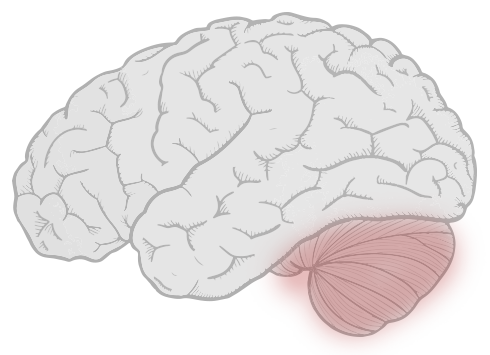Scientists at the RIKEN Center for Brain Science (CBS) in Japan have discovered how mutations related to a group of movement disorders produce their effects. Published in Proceedings of the National Academy of Sciences USA, the study found three ways in which mutations affecting the IP3R1 protein can affect the chemical balance of neurons in the brain, ultimately leading to the degeneration of motor control.
Among the many types of degenerative movements disorders, spinocerebellar ataxias are a group that result from dysfunction in the part of the brain called the cerebellum. The cerebellum allows smooth and coordinated movements such as walking and speaking. Spinocerebellar ataxias come in many types with different genetic origins. Recently, a spinocerebellar ataxia with very early infantile onset (SCA29) was shown to be associated with mutations that affect the protein receptor IP3R1, which is especially common in neurons of the cerebellum. Led by Katsuhiko Mikoshiba, the group at RIKEN CBS conducted a series of experiments to determine exactly how the many different mutations related to SCA29 affect IP3R1 function within cells.
Studying mutations in IP3Rs turns out to be difficult because nearly all cells have one or more of the three types. Although other researchers have made cells lines in which all three types have been deleted, the process of introducing mutant genes into them is inefficient and time consuming. Mikoshiba and his group used CRISPR genome-editing technology to create cells in which all three IP3R genes were disrupted. Introducing mutant or wildtype IP3Rs into these cells could be done very efficiently, which allowed them to complete the study much more quickly than could have been achieved otherwise.
The team looked at over 10 different mutations related to SCA29. “Surprisingly,” notes first author Hideaki Ando, “all of the SCA29 pathological mutations identified within or near the place that IP3 attaches to IP3R1 completely (not partially) blocked the calcium-releasing activity of IP3R1.”
Calcium is crucial for many cell functions, including signaling between neurons. When not being used, it is stored within cells. When IP3 attaches to IP3R1, it allows calcium to pass through so it can be released from storage when needed. By blocking calcium release, the SCA29 mutations prevent calcium from being able to do its job.
The team did further tests to determine how the different mutations disrupted calcium release. They found that in 9 of 12 mutations near the binding region, IP3 was prevented from binding to the receptor.

The cerebellum. Modified from Designed by Freepik
Two other mutants indirectly affected IP3R1 activity through mutations affecting the binding site of another protein—CA8. Normally when CA8 binds to the receptor, calcium release is suppressed. However, in the mutants, calcium release was higher than normal. CA8 mutations have also been identified in people with congenital ataxia and mental retardation. The team of scientists investigated how these mutations affected calcium flow through IP3R1, and found that they also prevented normal suppression of calcium release.
Understanding these molecular details mutations in IP3R1 is important for developing effective treatments. Ando explains, “Now we know that spinocerebellar ataxias can result from both suppressed or enhanced calcium release though the IP3 type 1 receptor. Therefore, drug development that enhances or inhibits IP3R1 activity may lead to effective treatments for these disorders. In fact, development of IP3R1 agonists or antagonists should benefit from our previous research in which we revealed the crystal structure of IP3R1.” ✅
Scientists at the RIKEN Center for Brain Science (CBS) in Japan have discovered how mutations related to a group of movement disorders produce their effects. Published in Proceedings of the National Academy of Sciences USA, the study found three ways in which mutations affecting the IP3R1 protein can affect the chemical balance of neurons in the brain, ultimately leading to the degeneration of motor control.
Among the many types of degenerative movements disorders, spinocerebellar ataxias are a group that result from dysfunction in the part of the brain called the cerebellum. The cerebellum allows smooth and coordinated movements such as walking and speaking. Spinocerebellar ataxias come in many types with different genetic origins. Recently, a spinocerebellar ataxia with very early infantile onset (SCA29) was shown to be associated with mutations that affect the protein receptor IP3R1, which is especially common in neurons of the cerebellum. Led by Katsuhiko Mikoshiba, the group at RIKEN CBS conducted a series of experiments to determine exactly how the many different mutations related to SCA29 affect IP3R1 function within cells.
Studying mutations in IP3Rs turns out to be difficult because nearly all cells have one or more of the three types. Although other researchers have made cells lines in which all three types have been deleted, the process of introducing mutant genes into them is inefficient and time consuming. Mikoshiba and his group used CRISPR genome-editing technology to create cells in which all three IP3R genes were disrupted. Introducing mutant or wildtype IP3Rs into these cells could be done very efficiently, which allowed them to complete the study much more quickly than could have been achieved otherwise.
The team looked at over 10 different mutations related to SCA29. “Surprisingly,” notes first author Hideaki Ando, “all of the SCA29 pathological mutations identified within or near the place that IP3 attaches to IP3R1 completely (not partially) blocked the calcium-releasing activity of IP3R1.”
Calcium is crucial for many cell functions, including signaling between neurons. When not being used, it is stored within cells. When IP3 attaches to IP3R1, it allows calcium to pass through so it can be released from storage when needed. By blocking calcium release, the SCA29 mutations prevent calcium from being able to do its job.
The team did further tests to determine how the different mutations disrupted calcium release. They found that in 9 of 12 mutations near the binding region, IP3 was prevented from binding to the receptor.

The cerebellum. Modified from Designed by Freepik
Two other mutants indirectly affected IP3R1 activity through mutations affecting the binding site of another protein—CA8. Normally when CA8 binds to the receptor, calcium release is suppressed. However, in the mutants, calcium release was higher than normal. CA8 mutations have also been identified in people with congenital ataxia and mental retardation. The team of scientists investigated how these mutations affected calcium flow through IP3R1, and found that they also prevented normal suppression of calcium release.
Understanding these molecular details mutations in IP3R1 is important for developing effective treatments. Ando explains, “Now we know that spinocerebellar ataxias can result from both suppressed or enhanced calcium release though the IP3 type 1 receptor. Therefore, drug development that enhances or inhibits IP3R1 activity may lead to effective treatments for these disorders. In fact, development of IP3R1 agonists or antagonists should benefit from our previous research in which we revealed the crystal structure of IP3R1.” ✅
Further reading
Ando H, Hirose M, Mikoshiba K (2018) Aberrant IP3 receptor activities revealed by comprehensive analysis of pathological mutations causing spinocerebellar ataxia 29. PNAS. doi: 10.1073/pnas.1811129115









